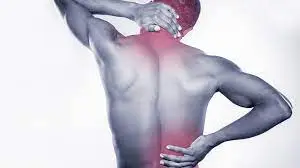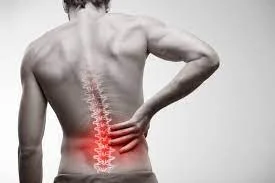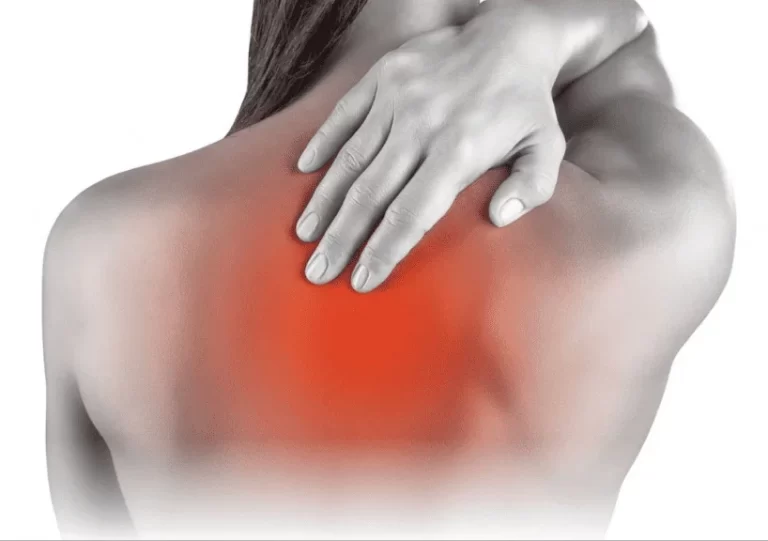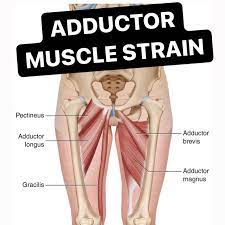Plantaris injury: Symptoms, Treatment, Exercise
Table of Contents
What is the plantaris injury?
Injuries to the plantaris muscle can either occur as a muscle strain or more commonly, a plantaris muscle rupture. Plantaris muscle ruptures have also been called “tennis leg”.
A plantaris injury may happen as an isolated injury, in combination with a soleus and gastrocnemius tear, or an ACL injury. Damage is most common in the proximal muscle belly or the musculotendinous junction but infrequently occurs through the tendon. Ruptures isolated to the distal tendon are tender to palpation 2 to 3 centimeters above the calcaneal insertion on the medial side of the Achilles tendon and are typically mildly swollen.
Anatomy of Plantaris muscle:
The Plantaris muscle is a small muscle with a short belly and long slender tendon that is located at the back of the leg and along with the Gastrocnemius and Soleus muscles forms the Triceps Surae. The long, thin tendon of plantaris is nicknamed the freshman’s nerve. While not as thick as the Achilles tendon, the plantaris tendon (which tends to be between 30–45 centimeters (12–18 in) in length) is the longest tendon in the human body. Not including the tendon, the plantaris muscle is approximately 5–10 centimeters (2.0–3.9 in) long & is absent in 8-12% of the population.
It is one of the plantar flexors in the back of the leg, along with the gastrocnemius and soleus muscles. The plantaris is regarded to have become an unimportant muscle when human antecedent switched from climbing trees to bipedalism and in anatomically modern humans it mainly acts with the gastrocnemius.
Origin: The plantaris muscle arises from the posterosuperior aspect of the lateral femoral condyle near the origin of the lateral head of gastrocnemius & also to the oblique popliteal ligament.
Insertion: The plantaris muscle is inserted into the posterior surface of the calcaneum via the calcaneal tendon.
Nerve supply: tibial nerve (S1, S2).
Blood supply: popliteal artery.
Actions: Assists other muscles at the knee and ankle joints.
Assists flexion of the knee
Mechanism of injury
The mechanism of injury to the plantaris muscle may be similar to that of the gastrocnemius – a sudden eccentric load while moving into ankle dorsiflexion with the knee extended – as occurs in jumping and sprinting. The athlete may feel like they have been hit in the back of the knee or upper calf. However, they may not lose power when running and jumping(sometimes referred to as tennis leg).
Tennis Leg refers to an acute medial head of the gastrocnemius muscle tear in the older athlete characterized by sudden onset of very severe calf pain and significant disability. The injury is invariably associated with extensive bruising & swelling, & can be mistaken for a deep venous thrombosis. The more common site is the medial head of gastrocnemius, and the plantaris muscle is involved. Symptoms are a sudden, sharp, or burning pain in the leg, many times accompanied by an audible sound. In more cases, the player is unable to resume play because of the severe pain. Depending on the severity of the injury, recovery may take between a few days & 6 weeks.
A plantaris injury may happen as an isolated injury, in combination with a soleus and gastrocnemius tear, or an ACL injury. Damage is most common in the proximal muscle belly or the musculotendinous junction but infrequently occurs through the tendon. Ruptures isolated to the distal tendon are tender to palpation 2 to 3 centimeters above the calcaneal insertion on the medial side of the Achilles tendon and are typically mildly swollen.
Symptoms of Plantaris injury
- An audible pop when the injury to the medial calf occurred is commonly reported.
- The patient complains of calf pain, which additionally radiates to the knee or the ankle. Also, the patient complains of pain with ankle movements.
- The patient complains of a swollen leg that extends down to the foot or ankle, & also the associated color changes of bruising.
- Tenderness is prominent upon palpation in the all medial gastrocnemius muscle, but this tenderness is observed to be exquisitely most painful at the medial musculotendinous junction.
- Palpation of the Achilles tendon might demonstrate an intact tendon.
- The peripheral pulses might be present and symmetric.
- Moderate to severe pain is denoted by passive ankle dorsiflexion (due to stretching of the torn muscle fibers) in the tennis leg, also with active resistance to ankle plantar flexion (due to the firing of the torn muscle fibers).
Examination and Diagnosis
Diagnosis of plantaris injury needs a diagnostic ultrasound scan as well as a clinical assessment.
A clinical assessment at Complete will include:
1) Clinical interview
To help formulate a hypothesis about tennis leg the clinician will ask a series of questions to understand how and why your pain begins. A medical history will also be taken to rule out another source of your pain including deep vein thrombosis (DVT). Deferentially diagnosing a DVT is of critical importance as DVT needs urgent medical assistance, involving anticoagulant medication.
2) Physical assessment
Physical assessment is used to locate the cause of symptoms and why they may have occurred. It includes:
Close observation of the calf muscle for improving heat, swelling, bruising, or calf muscle shape change (indicative of rupture)
Ankle & calf range of movement
Calf strength testing – can you stand on 1 leg or perform a heel raise?
Gentle palpation of the calf complex
Walking assessment.
3) Diagnostic musculoskeletal ultrasound scan
Diagnostic musculoskeletal ultrasound imaging is the main imaging modality for a calf muscle tear. It visualizes the injury better than an MRI scan & also provides information related to whether or not there is a large hematoma (fluid collection – see image below) in the calf (a common occurrence in this injury). On 1st appointment at Complete, we will carry out a scan (no extra charge) & will determine whether the fluid might be aspirated (drained) to help with pain levels & the healing of the tear.
Bright et al (2018) describe diagnostic ultrasound as capable of assessing the presence of calf injury, estimating the degree of severity & aid in its management by routinely monitoring the healing process throughout rehabilitation.
Medical treatment of plantaris injury
Treatment of a plantaris muscle injury is almost always non-surgical. Pain management might include analgesics as indicated. Caution might be used with non-steroidal anti-inflammatory drugs (NSAIDs) during the acute injury phase, as these agents can predispose the patient to increased bleeding and hematoma formation in the starting days after an injury. Theoretically, cyclooxygenase-2 (COX-2) inhibitors may provide pain control without the risk of bleeding in acute injuries, which is a cover with traditional NSAIDs.
Ankle/foot bracing might be used to keep the ankle in a position of maximal tolerable dorsiflexion. Studies have shown an improved rate of healing with this intervention.
Physiotherapy treatment of plantaris injury
The initial treatment of a plantaris injury is with the usual R.I.C.E. (rest, ice, compression, elevation) treatments.
Rest: Refused some activities that cause pain, swelling, or discomfort. don’t avoid all physical activity.
Ice: Ice is a tried-and-true tool for decreasing pain and swelling. Apply an ice pack (covered with a light, absorbent towel to help prevent frostbite) for 15-20 minutes every 2 to 3 hours during the first 24 to 48 hours after injury.
Compression: This means wrapping the injured part to prevent swelling. Wrap the affected part with an elastic medical bandage. You should be snug but not too tight. if it’s too tight, it’ll interrupt blood flow. If the skin under the wrap turns blue or feels cold, numb, or tingly, loosen the bandage. If these symptoms don’t disappear right away, seek instantly medical help.
Elevation: Elevate the leg on high of your heart’s extent, importantly at night time, that allows gravity to help reduce swelling.
Once the worst pain & swelling have subsided (after 1 to 2 days), begin to build up the training load. During this period, pain is a signal to rest. Do not cross the pain threshold, as this will slow down the healing process. The training load is built up in 3 steps. These are described below, with several tips.
Step 1. Improvement of General Condition
If the pain permits it, may place weight on the foot, if necessary using elbow crutches during the 1st week. The foot might be used in a normal fashion.
A heel lift (with shock absorption) in both shoes for 1 to 2 weeks may help to ease the load on the calf muscles during walking. ‘Viscoheels’ are very useful for this cause.
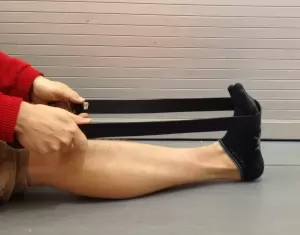
Stretching exercise:
- Towel stretch:
Sit on a firm surface with one leg stretched ahead of you.
Loop towel circling toes and the of foot and pull the towel toward body keeping knee straight.
now hold this position for 15 to 30 seconds and then relax.
Repeat 3 times.
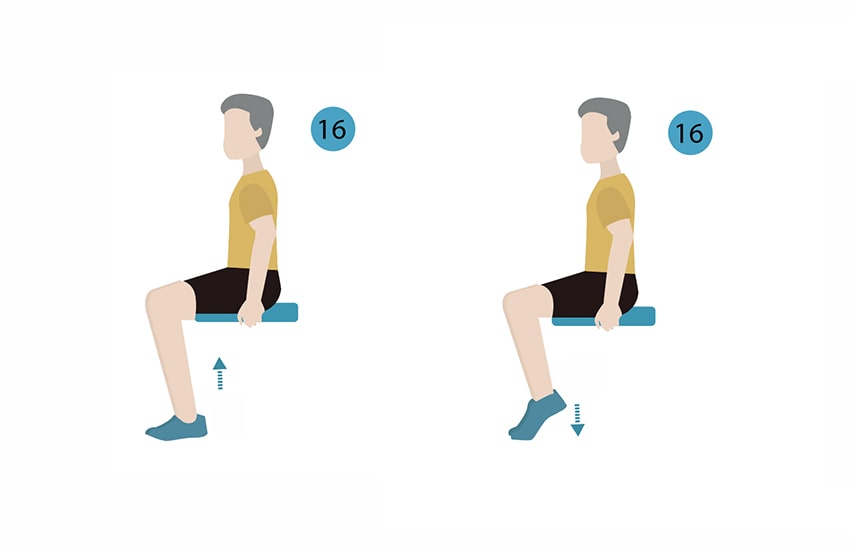
2. Seated Heel Raises
Sit in a chair with both feet on the floor. Pressing down through the toes, raise heels off the floor.
Hold this position for 10 seconds, then lower. Repeat 10 times.
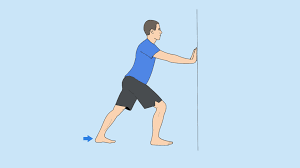
3. Standing calf stretch
Stand near a wall with 1 foot in front of the other, front knee slightly bent.Keep your back knee straight, your heel on the ground, and lean toward the wall. Feel the stretch all along the calf of your back leg. Hold this stretch for 15-20 seconds.
Switch legs, then alternate for a total of 3 repetitions.
Strengthening exercise of plantaris muscle injury:
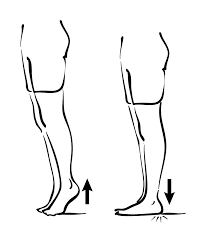
Double-Leg Calf Raise: Calf raises are a calf-strengthening exercise. They use for body weight to strengthen and tone the gastrocnemius and soleus. Stand near a wall or bench for balance. Place your feet hip-width apart & ankles, knees, and hips are in vertical alignment to protect your joints. Push down into the balls of both feet to raise the body up. Keep the abdominal muscles pulled in so move straight rising &shifting body side to side
Single-Leg Calf Raise: In starting position stand on one leg near a wall or bench for balance with the other leg bent. the ankle, knee, and hip of the leg are in vertical alignment to protect the joints. push down into the ball then foot to raise the body upward. The abdominal muscles are pulled in so avoid shifting backward or forward.
Seated Calf Raise: These exercises are done at home or at the gym on a calf exercise machine. The exercise works on both the muscle gastrocnemius and soleus.
Calf-Building Sports: The following sports will help both strengthen and tone your calves Running, walking, hiking, and swimming are the magnificent calf strengthening exercise. Running sports like soccer, basketball, and tennis dictate you to run, jump and push the calf muscles to bundled. it is great for toning.
Step.2 Build up
As soon as all the above exercises can be performed & walking is possible without pain, a return to tennis & other sports can be considered.
Start by strengthening the calf muscles. Slowly rise onto your toes and hold this position for 10 to 20 seconds. Then return to the starting position. Perform this exercise with both feet at the same time, then when leaning on the injured leg only. If using body weight is too painful or difficult, elastic tubing may be used to work the plantar flexors (i.e. push the toes and forefoot down against the resistance of the elastic tubing).
Take small, quick steps on the spot, alternating the left & the right leg.
If this goes well, you can start jogging. begin with an easy jog, then continue some sprints and straight running, followed by fast turns, starts, and stops.
Finally, you can consist jumping exercises.
Step 3. Return to Play
A return to the tennis court might now be possible. continue against the practice wall or with mini tennis & gradually increase the distance to the wall or your opponent on the court. Check your position yourself well for the ball by taking small steps. In this phase, you can also add volley exercises. Slowly (in the course of 1 to 2 weeks) include more exercises that involve moving longer distances toward the ball. Next, add low volleys, followed by overheads and services. As soon as you can hit a smash with footwork without problems, you are ready to start playing points, games & or a practice match. Once you have played practice matches for 2 weeks in succession without problems, you can start playing matches again.
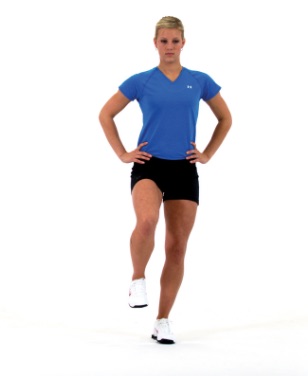
Do these exercises after you’ll stand on your toes while not in pain.
- Single leg balance:
Stand with no support and arrange to balance on one leg.
Repeat three times.
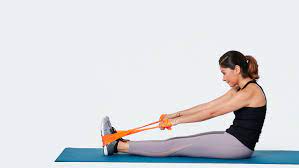
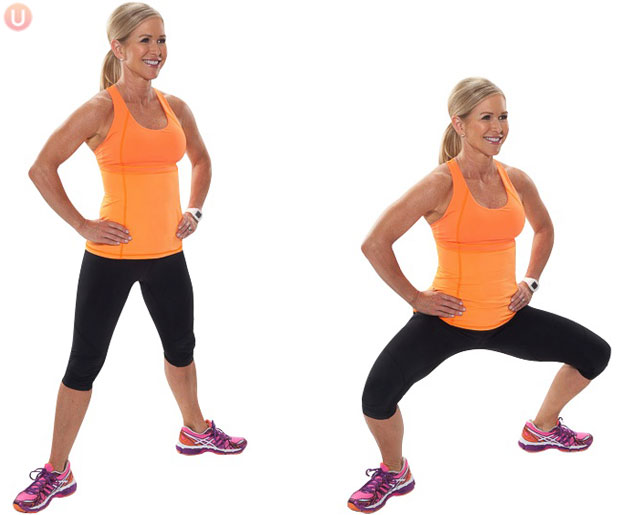
- Resistance Band Calf Exercise:
Wrap the band around the end of your foot and press down into the band, extending your toe and engaging the calf.
Hold this position for three seconds, then slowly relax to the starting position.
Perform 10 to 15 repetitions. Switch legs and repeat. - Full squat:
Your hips go down below your knees.
Perform 10 to 15 repetition
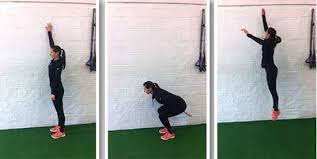
4. wall jump:
you have to face a wall and place a piece of masking tape regarding a pair of feet higher than your head.
After that jump up together with your arms higher than your head and take a look at the touch of the piece of tape. check that you are doing -a “spring” variety of motion and don’t land hard on your feet. improve to taking off and landing on a single foot. Do three sets of ten.
How to prevent plantaris injury?
Prepare: The best way to prevent tennis leg and muscle strains is to sufficiently warm-up prior ro playing. I know no one likes to make time to warm-up, but it is critical for injury prevention. Get to the court early to perform dynamic warm-up. A 5-7 minute dynamic warm-up is ideal within 15 minutes of match time. This includes movements to help lengthen muscles to prepare for tennis and increases heart rate and body temperature so body is warm, which may help decrease risk for injury. Once compete dynamic warm-up, grab racket and start hitting.
Recover: Immediately following match, stay on the court to stretch arms and legs. They just did a lot of work so help the muscle cool down so aren’t stiff or sore the next day. Stretching helps maintain flexibility & joint mobility. Hold each stretch for about 30 seconds. A few of my favorite stretches are best done on the floor, so it is ideal to throw a yoga mat down and finish stretching in the club house or locker room. Cool-down stretching should be done within 30 minutes of coming off the court, so do this before shower and change clothes.
Roll it out: Foam rolling is a great way to stretch and massage muscles and fascia after play. I recommend combining this with stretching. Roll each muscle for about 30 seconds.
Repair: At the end of the day, take a warm bath with 1-2 cups of Epsom salts for about 15 minutes. The magnesium sulfate in the Epsom salts is soothing for sore, tight and tired muscles and diminishes pain and muscle tension promoting more restful sleep. So, take bath before bedtime.
Protect: If you have experienced a calf muscle strain or Tennis leg, consider applying a compression sleeve around the lower leg. During the cool weather months, adapt clothing to the weather conditions. It may be a good idea to wear pants, running tights, or compression gear to keep legs warm. Well-warmed muscles are better able to withstand pulling & traction forces than cold muscles.

